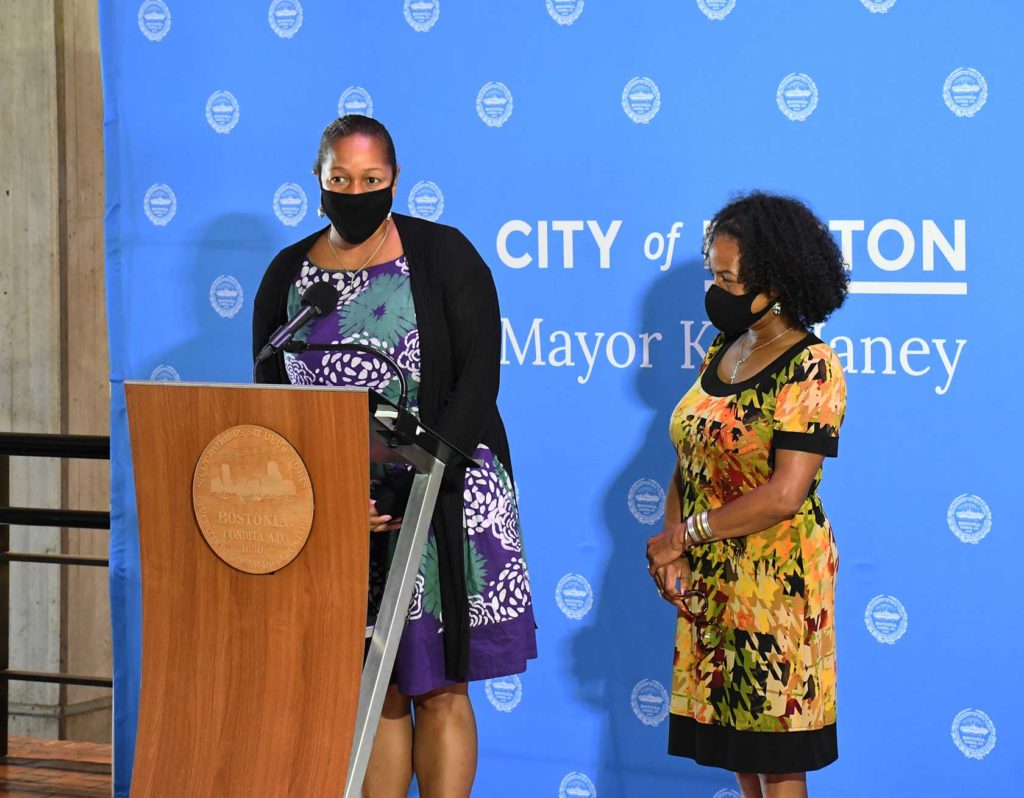Janey requests state withdraw harbor plan
Cites climate change-fueled storm surges, public access

Acknowledging the recent tornado warnings and a close call with a hurricane that affected Massachusetts in recent weeks, acting Mayor Kim Janey announced Aug. 26 that she is asking the state to withdraw the Downtown Waterfront District Municipal Harbor Plan that had been submitted by the Boston Planning and Development Agency (BPDA).
The plan, which came out of a four-year development process, was submitted in 2017 to the state for approval. It was approved by the then-Secretary of the Executive Office of Energy and Environmental Affairs, Matthew Beaton, in 2018 and was subsequently the subject of a lawsuit from the Conservation Law Foundation (CLF) the same year.
The CLF sued on the grounds that, under state law, it is the responsibility of the Department of Environmental Protection to approve waterfront plans. In April, the Suffolk Superior Court ruled in favor of the CLF rendering the plan not in effect.
Now, Janey has asked the state to withdraw it to allow for Boston to begin work on a new plan from scratch, to create guidelines that are more equitable and climate-resilient.
“The downtown waterfront should provide access to all Boston residents, and the Municipal Harbor Plan is not embedded in equitable access or cutting-edge resiliency efforts to the extent needed if we’re going to tackle climate change,” Janey said in a press conference. “Moving forward, climate resiliency and equity must be driving factors in development.”
That process will include meeting with stakeholders such as residents, environmental justice organizations and experts in waterfront development to develop alternative ideas that will better serve the city in terms of resiliency and accessibility.
Janey said specific goals of the process will include increasing waterfront resilience, expanding access equitably, putting forth a net-zero requirement for development in affected areas, maintaining economic vitality and increasing the city’s green space.
While the process to develop the original plan took four years, the city hopes the new process will be faster. Janey said that with a changing climate, developing a new plan requires urgency.
“We cannot continue to wait; we have put this off for too long and this is an opportunity for us to move our city forward in a way that engages residents in making sure that we are embedding the values of resiliency and equity in our future plans in a more meaningful way,” Janey said.
Mariama White-Hammond, chief of Environment, Energy, and Open Space for the city, pointed to the Climate Ready Downtown and Climate Ready North End plans released September 2020 as a starting point that she hopes will speed the process.
“We’re not planning for another long, long process,” White-Hammond said. “We think we have some things to start from, but we will be embedding equity and resilience as the core goals to start the process.”
When asked what embedding those goals means in practice, Janey described a need to think of the future of all residents and neighborhoods in Boston.
“We have an obligation, I believe, and an opportunity to make sure, as we plan for our future, not just to protect future generations, to make sure we’re doing everything right now to mitigate the impact of climate change,” Janey said. “… We have a chance here to make sure we are creating more access to, not only the downtown waterfront, but that we are acting in waterfront neighborhoods all across Boston — whether South Boston, Dorchester, East Boston, North End, Charlestown — and we want to make sure our waterfront is welcoming, inclusive — not just resilient — to every resident in our city.”
At the press conference, Janey also announced the BPDA is adding a coastal flooding zoning overlay to the city’s zoning code. The overlay will require projects in affected areas to take additional steps to limit the damage and displacement caused by coastal storm flooding. The overlay will apply to areas that would be impacted by 40 inches of sea-level rise in a storm event that has a 1% chance of occurring in a given year.
Janey said that, for developing a new harbor plan, she hopes all the necessary governing bodies can come together in the process.
“It’s going to take all of us; not just the city, certainly our commonwealth and every resident, every organization that cares about climate justice issues,” Janey said. “We all have to do our part to make sure we are dealing with and addressing this issue with the urgency it requires.”






